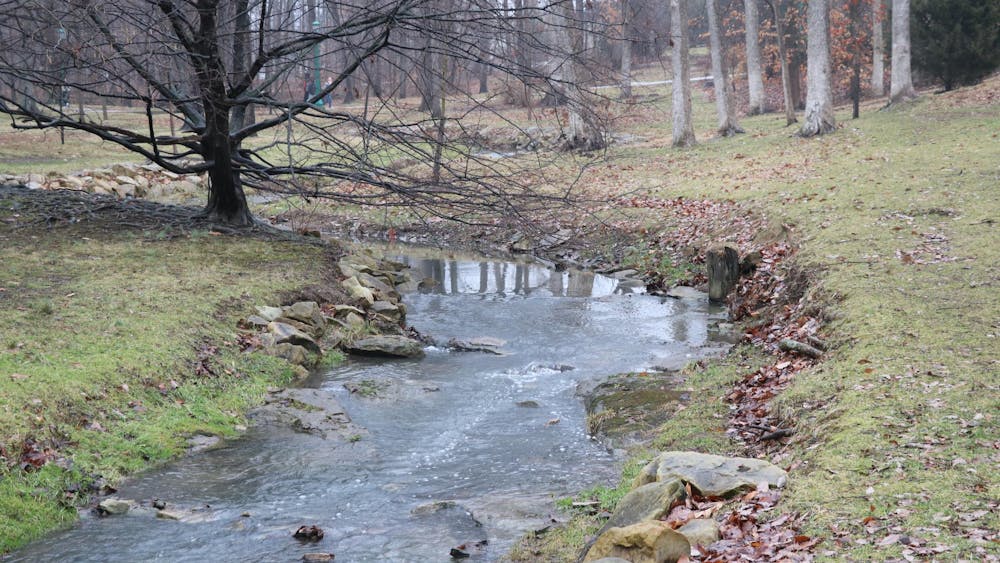When construction crews began work on the Interstate-69 project near her home in March, Indian Creek Township resident Sandra Tokarski noticed something wrong.
Heavy rain accumulated near her home about 13 miles southwest of Bloomington, and she said she discovered in a streambed on her property a sediment runoff that could cause environmental and health problems.
Tokarski argued the state has not used adequate erosion control to ensure sediment does not run into the intermittent stream on her property, which empties into Indian Creek. Although the Monroe County Plan Commission has showed interest in alleviating the issue, she said she and her husband Thomas Tokarski have received little response from the Indiana Department of Transportation and Indiana Department of Environmental Management after filing complaints with state and federal agencies.
“I-69 is too political for them to do what they should do, which is to stop the project until they find a way to do it without contaminating underground waters and surface waters,” Tokarski said.
The Section 4 corridor of I-69, which runs through Indian Creek Township, extends from Crane to Bloomington. Section 4 is scheduled to open by the end of 2013, according to the I-69 Evansville to Indianapolis project website.
Scott Wells, a member of the Commission, said they addressed the water quality complaint in a letter to the Indiana Department of Environmental Management, the Indiana Department of Natural Resources, the Indiana Department of Transportation, the U.S. Fish and Wildlife Service, the Environmental Protection Agency and the U.S. Army Corps of Engineers.
INDOT issued a response to the I-69 concerns about two months later, on Sept. 9.
“As INDOT receives complaints or identifies concerns with erosion control or sediment, our staff immediately begins working on the necessary corrective action,” Elliott Sturgoen, I-69 director of operations, wrote in the response. “INDOT takes the conditions and commitments that have been set through the environmental studies and design of Section 4 of I-69 very seriously.”
Significant rainfall was blamed for the sediment contamination in the water.
Will Wingfield, the state media contact for INDOT, said the department requires erosion control measures capable of addressing two inches of rain per hour during a rainstorm. Wingfield said more than two inches per hour would be a significant rainstorm.
The area received significant rainfall on June 26 and 27, with up to six inches of rain per hour, exceeding the design capacity, Wingfield said.
“Since that time, we immediately cleaned up what was in our right of way,” Wingfield said.
When shovels and five-gallon buckets were not enough to remove the sediment erosion, Wingfield said INDOT brought in vacuum trucks to finish the job.
“Basically, our permit is such that if sediment goes off-site, then it is our contractor’s No. 1 priority to clean that up,” Wingfield said.
Clean-up can be a slow process, Wingfield said, because once it is off-site, the department has to work with neighboring property owners to get access.
Wingfield said INDOT’s erosion control measures are in place because, while sediment occurs naturally in water, an excessive amount can cause problems.
IDEM Public Information Officer Dan Goldblatt said IDEM has been working with contractors to mitigate contaminated water, and they have a full-time staffer on-site to make sure of it.
IDEM aims to prevent sediment runoff so INDOT does not have to mitigate the problems afterward, Goldblatt said.
Goldblatt said a common pretreatment is putting down sand and rock to catch the water runoff, allowing the water to run through while trapping the sediment.
This keeps rainwater and sediment out, unless there is an extreme rain event,
Goldblatt said.
Despite the significant rains, Monroe County Drainage Engineer Todd Stevenson said more could have been done to keep the sediment out of the water. He said spreading mulch over the ground would have been a way to help reduce the amount of sediment that left the site.
“That is something that has been done in various degrees, but in my observation, it has not been done as well as it should have been done,” Stevenson said.
Stevenson said the biggest problems with sediment runoff so far have been in the Indian Creek watershed.
“I have been out there after heavy rain events, and I have seen the mud that has come off I-69 into receiving streams and onto adjacent properties,” Stevenson said.
Stevenson said the sediment is also getting into springs. One family who uses its spring to wash clothes is unable to do that when it gets muddy, he said.
“The last week or two ago they built some dams to control sediment that should have been there all along,” said Indian Creek Township resident Clark Sorensen. “They are backtracking and adding things that should have been there the whole time.”
Sorensen said he has been opposed to I-69 all along and wishes people would do the right thing so the environmental impacts would be minimized.
“They are cutting corners every chance they get, and it takes a toll on the environment when they do that,” Sorensen said.
Follow reporter Mary Hauber on Twitter @mary_hauber.
Sediment runoff from I-69 construction a concern in Indian Creek Township
Get stories like this in your inbox
Subscribe





